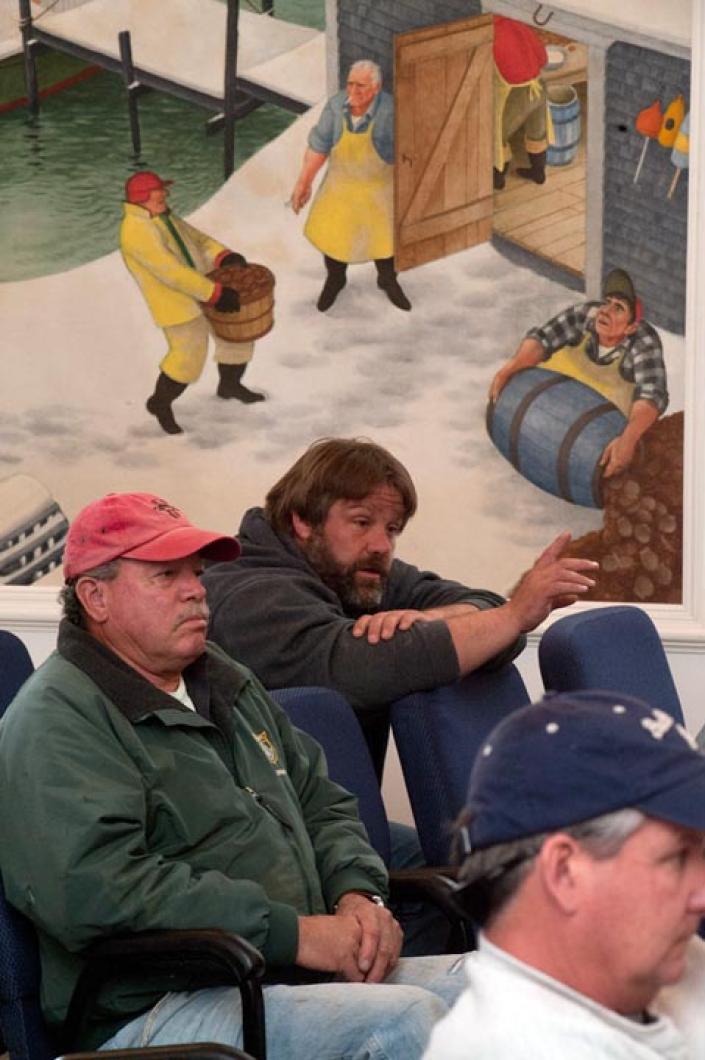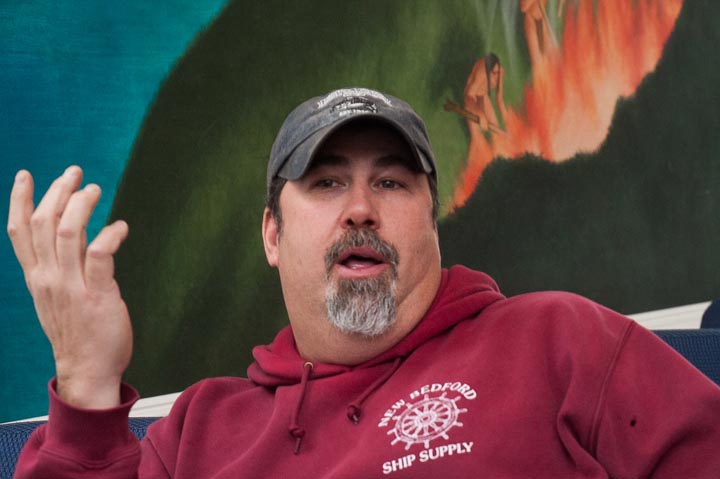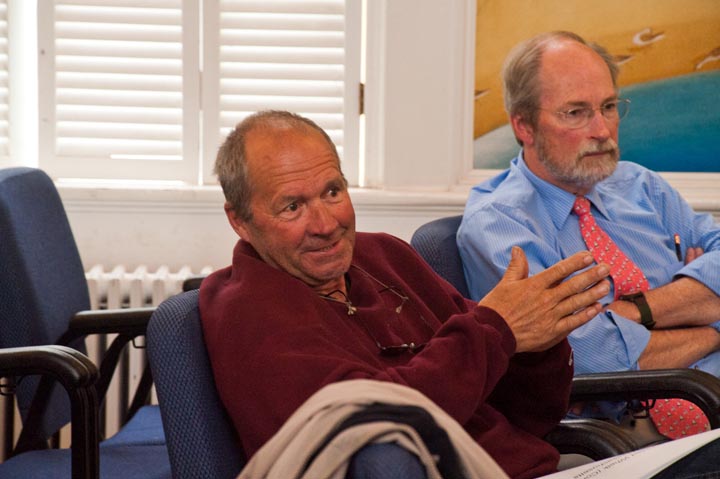State fisheries officials have warned Vineyard conch fishermen that if significant conservation measures aren’t taken soon, the Island’s biggest fishery will collapse and be difficult to restore. After meeting last Friday with the state officials, a number of local fishermen said the conch fishery is in serious trouble and the state can’t act fast enough.
More conch—also called channeled whelk—is landed by fishermen at the dock than any other species, including lobster, striped bass and other finfish. Two years ago, conch fishermen landed $839,466 worth of product at the dock weighing a million pounds. Statewide, conch fishermen have been landing close to 3 million pounds a year since 2006.
Conch are caught in a similar manner as lobsters. A pot is put on the bottom and marked by a floating buoy. Most of these mollusks come from Nantucket Sound, and to a lesser extent Vineyard Sound and Buzzards Bay.
With the current 2.75-inch minimum size, Steve Wilcox, a state marine fisheries biologist, warned: “We are harvesting most of the female conch before they’ve had a chance to reach sexual maturity.” Mr. Wilcox said state data suggest the fishing effort has increased significantly, along with its popularity. Even with a 3.50 inch minimum size, a proposal under consideration, about half of the catch will include females that have not reached sexual maturity. Because it takes some conch six to eight years to reach adult age, the fishermen are taking the conch before they’ve reproduced.
“I can see this fishery collapse. It is only a matter of time,” said William “Billy” Alwardt, an Oak Bluffs fisherman. He said he and other fishermen have been complaining about overfishing for years and added that local fishermen wrote a letter to the state two years ago asking for a three-inch minimum size, which, it turns out, probably would not help the conch population.
“I know we are overfishing,” said Mr. Alwardt. “At one time this past fall, I looked up from my [boat] windshield: There were 5,000 traps in one spot. It is out of control. It is totally out of control.”
Mr. Alwardt said further that some of the places where he used to fish are already without conch. “In the 1980s, there were less than 20 boats [fishing conch],” he said. “Now we are looking at 50 boats. There are 25 boats right here [from the Vineyard]. It is only a matter of time. If the data is correct and they aren’t reproducing until they are 3.5 inches in size, we are in trouble. These animals don’t even get to breed. It is sad. I am losing a living I have always depended on.”
Bob Glenn, a state senior marine fisheries biologist, said rewriting the regulation to create a three-inch minimum size will probably not protect the conch. He said raising the size to 3.5, would at least protect 50 per cent of those reaching sexual maturity.
A number of fishermen at the Vineyard meeting at the Katharine Cornell Theatre in Vineyard Haven said that going to a 3.5 inch minimum size will severely cut into their landings, but it would save the fishery.
Conch are far more vulnerable to overfishing than fish and even lobsters, he said. “Lobster is at an all-time low,” he said. Lobsters, however, have been known to swim and will migrate. This means that if lobsters are depleted in one place, repopulation can come from lobsters migrating from another area.
But conch don’t move very much, Mr. Glenn said. He warned that there are areas in Europe where conch have been removed and restoration has failed. “Once they are gone, there is no alternative,” Mr. Glenn said.
David “Tubby” Medeiros of Edgartown suggested that the state close the conch fishing season when the animals are laying their eggs around August. He said it is a time of the year when conch are the hardest to catch. Mr. Medeiros’s comments were joined by Mr. Alwardt’s.
“We fish on them for 2 1/2 months in the spring and then whack them again in the fall,” Mr. Alwardt said. “From August to September the catches are low. I haul my gear in August.”
Potentially, it might be helpful to close part of the season in August, Mr. Glenn agreed. “But it isn’t the magic bullet.”
Among the ideas offered for controlling the harvest was one proposal requiring that the permit holder be the one operating the boat, which is a requirement for lobstermen. It was suggested at the meeting that some captains operating the boats are neither the owner nor permit holder. Making that a requirement will restrict the number of fishermen. Other fishermen agreed, including Warren Doty, president of the Martha’s Vineyard/Dukes County Fishermen’s Association.
State officials are also looking at stepping up the level of enforcement by cracking down on lobstermen who are catching conch without the appropriate licenses. Some lobstermen facing declining lobsters are using horseshoe crabs as bait in their lobster pots, a common conch bait. Many lobstermen are also conch fishermen. The gear on the boat is pretty much the same, though the pot and the bait are different.
Eric Rodegast, a West Tisbury fisherman, said he didn’t want to see the state taking its time to make a decision in this matter for another year.
Dan McKiernan, deputy director of the division of marine fisheries, said, “We are not going to wait for a year, we are going to try and do something.”
On Tueday night, the state hosted another hearing on conch in Bourne. Over 70 fishermen and seafood dealers attended.
Mr. McKiernan said the state fisheries advisory committee plans to meet in May and will discuss what to do about the fishery.
Mr. McKiernan said that for this summer, the state could step up enforcement of regulations. But raising the minimum size to 3.5 inches is a lengthy legal process that probably wouldn’t be put in place for a year.









Comments
Comment policy »